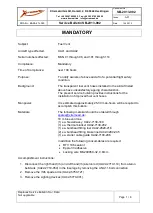
3-8
P/N 13772-005
Section 3
Cirrus Design
Emergency Procedures
SR22T
Engine Failures
Engine Failure On Takeoff (Low Altitude)
1. Best Glide or Landing Speed (as appropriate)............ ESTABLISH
2. Mixture ............................................................................. CUTOFF
3. Fuel Selector............................................................................OFF
4. Ignition Switch..........................................................................OFF
5. Flaps ...................................................................... AS REQUIRED
If time permits
:
6. Power Lever ............................................................................IDLE
7. Fuel Pump................................................................................OFF
8. Bat-Alt Master Switches...........................................................OFF
9. Seat Belts...................................................... ENSURE SECURED
Amplification
• WARNING •
If engine failure is accompanied by fuel fumes in the cockpit,
or if internal engine damage is suspected, move Mixture
Control to CUTOFF and do not attempt a restart.
If the engine fails immediately after becoming airborne, abort on the
runway if possible. In most cases, when the engine fails below 500 feet
AGL, the landing should be made straight ahead, turning only to avoid
obstructions. In such a case, lower the nose to maintain airspeed and
establish a glide attitude. If the engine fails between 500 feet and 2000
feet AGL, CAPS activation most likely is the safest option. After
establishing a glide for landing or activating CAPS, perform as many of
the checklist items as time permits.
Original Issue
















































